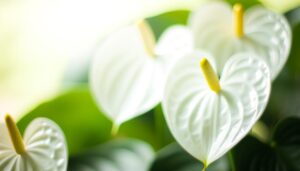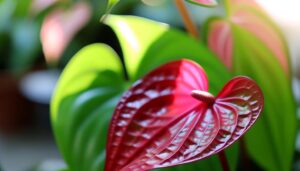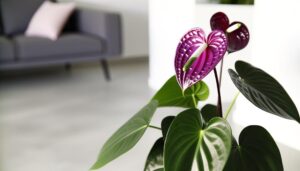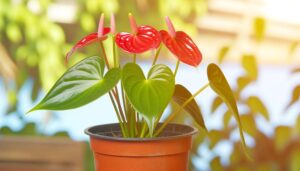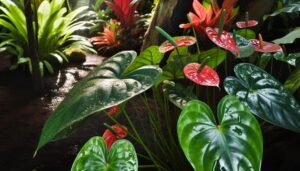Why Is the Anthurium Pink Princess Unique?
The Anthurium Pink Princess is distinguished by its chimeric cell mutations that result in striking variegated leaves with vibrant pink hues, attributable to anthocyanin pigments. Its compact growth pattern and unique stem coloration set it apart.
Originating from the tropical rainforests of Central and South America, it requires precise horticultural care, including ideal light, humidity, and soil conditions, to thrive. Propagation poses challenges due to its need for specific environmental controls and genetic fidelity.
Its rarity and unpredictable leaf patterns make it highly sought after by collectors. Learn more about its intricate care and propagation techniques ahead.
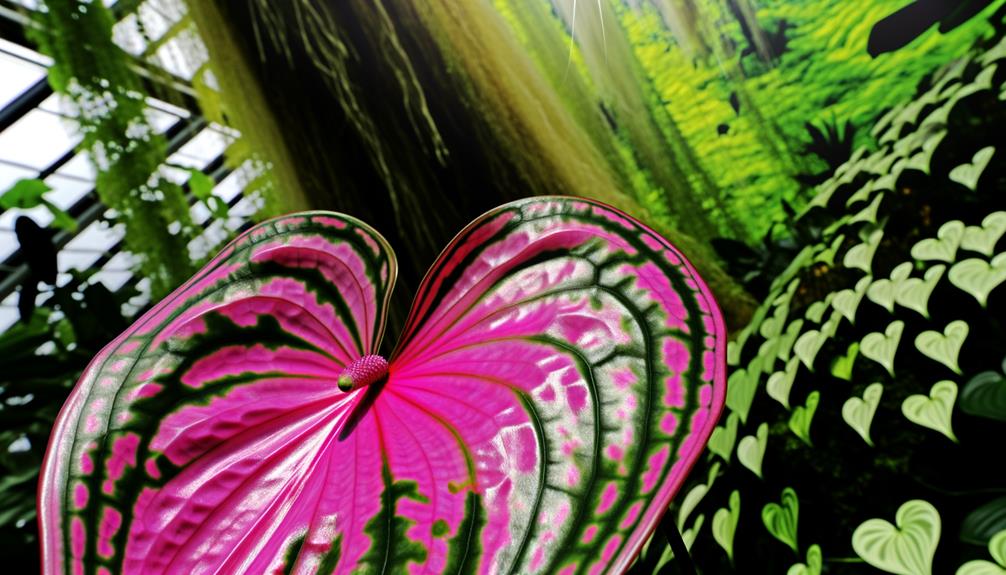
Key Takeaways
- The Anthurium Pink Princess features variegated leaves with vibrant pink hues due to chimeric cell mutations affecting chlorophyll expression.
- Its unique coloration comes from anthocyanin pigments, giving the plant striking and unpredictable leaf patterns.
- Originating from Central and South American rainforests, it has a compact growth pattern and distinct stem coloration.
- The plant's meticulous care requirements and rare status make it highly sought after by collectors.
- Vegetative propagation is necessary due to unreliable seed transmission, contributing to its rarity and limited availability.
Striking Variegated Leaves
The Anthurium Pink Princess is renowned for its striking variegated leaves, which exhibit a unique and visually enchanting pattern of pink and green pigmentation due to chimeric cell mutations.
This variegation arises from the differential expression of chlorophyll within the plant's cells, leading to sectors of photosynthetically active green tissue juxtaposed with non-photosynthetic pink regions. These chimeric mutations occur in the meristematic cells, causing random and unpredictable variegation patterns.
The contrast between the chlorophyll-rich green zones and anthocyanin-pigmented pink areas creates a visually enchanting specimen. This phenomenon not only enhances the ornamental appeal but also underscores the complexity of plant developmental biology.
The variegation's stability is influenced by genetic and environmental factors, making cultivation a meticulous process.
Vibrant Pink Coloring
The vibrant pink coloring of the Anthurium 'Pink Princess' is primarily attributed to anthocyanin pigments, which result from specific genetic expressions and environmental conditions.
This natural pigment variation plays a pivotal role in the plant's ability to attract pollinators, while also contributing to its high ornamental value.
The eye-catching aesthetic appeal of the pink hues enhances the visual interest and marketability of this unique cultivar.
Natural Pigment Variation
Natural pigment variation in Anthurium Pink Princess results from the differential expression of anthocyanin compounds, leading to its characteristic vibrant pink coloring.
Anthocyanins, a class of flavonoid pigments, are synthesized through the phenylpropanoid pathway, where specific enzymes such as chalcone synthase and dihydroflavonol 4-reductase play pivotal roles.
The concentration and distribution of these pigments within the plant's cellular structures, particularly in the vacuoles of epidermal cells, are influenced by genetic and environmental factors.
Light intensity, pH levels, and nutrient availability can further modulate anthocyanin biosynthesis.
This intricate regulatory mechanism contributes to the unique and striking coloration patterns observed in the Anthurium Pink Princess, distinguishing it from other Anthurium cultivars.
Eye-catching Aesthetic Appeal
Building on the understanding of natural pigment variation, the Anthurium Pink Princess captivates with its vibrant pink coloring. This color not only serves as a hallmark of its aesthetic appeal but also underscores the intricate biochemical processes driving anthocyanin accumulation.
Anthocyanins, water-soluble vacuolar pigments, manifest in various hues depending on pH levels and metal ion presence, resulting in the distinctive pink coloration. This chromatic phenomenon is a product of complex genetic and environmental interactions, including light exposure and nutrient availability.
The variegation, where pink seamlessly blends with green foliage, is achieved through a meticulous balance of chlorophyll and anthocyanin synthesis. This botanical marvel not only intrigues horticulturists but also elevates the plant's desirability among collectors.
Unique Growth Pattern
The Anthurium Pink Princess exhibits a distinctive growth pattern characterized by its variegated leaf patterns. This is where chlorophyll-deficient pink sectors juxtapose with the green, photosynthetically active regions.
This cultivar maintains a compact plant size, which is advantageous for indoor cultivation and space-constrained environments. Additionally, the plant's stems display a unique coloration, often presenting a striking contrast with the foliage, further enhancing its ornamental appeal.
Variegated Leaf Patterns
Variegated leaf patterns in the Anthurium Pink Princess result from a genetic mutation that disrupts chlorophyll production, leading to a mosaic of green and pink sectors within individual leaves.
This mutation affects the chloroplasts, creating areas deficient in chlorophyll, which appear pink due to the underlying anthocyanin pigments. The variegation is not uniform and can vary in intensity and distribution across leaves, contributing to the plant's unique aesthetic appeal.
This phenomenon is scientifically referred to as chimeric variegation, where somatic cells contain different genetic compositions.
The unpredictable nature of this variegation makes each specimen distinct, adding to its desirability among plant enthusiasts.
Cultivating such plants requires precise environmental conditions to maintain the balance between variegated and non-variegated tissue.
Compact Plant Size
Due to its unique growth pattern, Anthurium Pink Princess displays a compact plant size, characterized by shorter internodes and a rosette-like leaf arrangement. This morphological trait results from the plant's distinct cellular growth dynamics, where apical meristem activity is finely regulated, promoting stunted axial elongation.
The shortened internodes contribute to a dense foliage canopy, optimizing space utilization and light interception. Additionally, the rosette-like leaf arrangement maximizes photosynthetic efficiency while minimizing spatial competition.
These compact growth characteristics are particularly advantageous for ornamental horticulture, as they facilitate easier management and aesthetic appeal in confined spaces. The Anthurium Pink Princess stands out not only for its variegated leaves but also for its efficient, space-conserving growth habit.
Distinct Stem Color
Exhibiting a striking feature, the Anthurium Pink Princess showcases a distinctive stem color, attributed to the differential expression of anthocyanin pigments within its vascular tissues.
This unique pigmentation manifests as vibrant shades of pink and burgundy, creating a visually captivating contrast against the plant's green foliage.
The anthocyanins, which are flavonoid compounds, accumulate in the stem tissues due to certain genetic expressions and environmental stimuli, such as light intensity and pH levels.
This chromatic variation not only contributes to the plant's aesthetic appeal but also plays a role in its physiological processes, including photoprotection and antioxidative defense.
The interplay of genetic and environmental factors results in a growth pattern that is both unique and scientifically engaging.
Tropical Origins
Originating from the lush, humid rainforests of Central and South America, the Anthurium Pink Princess thrives in the understory layer, where it benefits from dappled sunlight and rich, well-drained soil. This unique epiphyte exhibits adaptations such as aerial roots for nutrient absorption and water uptake from the surrounding moist air. The following table elucidates key environmental conditions:
| Parameter | Ideal Range |
|---|---|
| Temperature | 65-80°F (18-27°C) |
| Humidity | 70-90% |
| Light | Indirect, filtered sunlight |
| Soil pH | Slightly acidic (5.5-6.5) |
These conditions mirror its native habitat, contributing to its distinct growth patterns and vibrant foliar variegation. Understanding these parameters is essential for emulating its natural environment, ensuring healthy development and sustained ornamental appeal.
Care Requirements
Proper care for the Anthurium Pink Princess requires meticulous attention to its environmental conditions, encompassing light, humidity, temperature, and soil composition to replicate its native tropical habitat.
Best light includes bright, indirect sunlight, avoiding direct exposure to prevent foliar damage.
Humidity levels should be maintained between 60-80%, achieved via humidifiers or misting.
The temperature range should remain between 16-27°C (60-80°F) to mimic its tropical origins.
Soil composition is essential; a well-draining, aerated mix, rich in organic matter, such as a blend of orchid bark, perlite, and peat moss, ensures adequate root respiration and moisture retention.
Managing these parameters meticulously will promote the health and unique variegation characteristic of the Anthurium Pink Princess.
Propagation Challenges
Propagation of the Anthurium Pink Princess presents several challenges due to its specific requirements for successful root development and genetic stability.
Ensuring prime conditions for adventitious root formation necessitates precise control of humidity, temperature, and substrate quality. Cuttings must be taken from mature, disease-free parent plants to minimize pathogen transmission.
Additionally, achieving the desirable variegation in offspring is complicated by genetic variability; somatic mutations often result in unpredictable phenotypic expressions.
In vitro propagation techniques, such as micropropagation, are employed to maintain genetic fidelity, yet they demand stringent aseptic conditions and professional expertise.
Despite these complexities, mastering these propagation protocols is essential for sustaining the vitality and ornamental value of the Anthurium Pink Princess in horticultural collections.
Popularity Among Collectors
Despite the complexities of propagation, the Anthurium Pink Princess remains highly sought after among plant collectors due to its striking variegation and unique coloration.
The plant exhibits a distinctive mosaic of pink, green, and black hues, attributed to its chimeric genetic structure, which results in asymmetrical pigment distribution. This variegation is not only visually appealing but also genetically rare, making each specimen a unique entity.
Collectors are particularly drawn to the unpredictable nature of its leaf patterns, which can vary significantly even within a single plant.
Moreover, the Anthurium Pink Princess's robust morphology and adaptive physiology contribute to its desirability, as it can thrive in diverse indoor environments, provided its specific horticultural requirements are meticulously met.
Rare Plant Status
Frequently classified as a rare horticultural specimen, the Anthurium Pink Princess owes its scarcity to the intricate genetic mechanisms governing its variegation and the challenges associated with its propagation.
The variegation results from a genetic mutation that leads to chlorophyll deficiency in certain leaf tissues, producing the iconic pink and green pattern. This mutation is not reliably passed through seeds, necessitating vegetative propagation methods such as stem cuttings.
However, even with clonal propagation, maintaining the desired variegation proves challenging, as environmental factors can affect pigmentation stability. Moreover, the slow growth rate of Anthurium Pink Princess exacerbates its rarity, limiting its availability in the market.
Consequently, these factors collectively contribute to its status as a coveted rarity among plant enthusiasts.
Conclusion
The Anthurium Pink Princess stands as a botanical marvel, characterized by its striking variegated leaves and vibrant pink hues. Its unique growth pattern, tropical origins, and intricate care requirements make it a gem among horticultural enthusiasts.
The propagation challenges further elevate its allure, rendering it a rare specimen in plant collections. Like a rare jewel in a crown, its popularity underscores its exceptional status and the intricate dance between nature and nurture in cultivating such a specimen.

